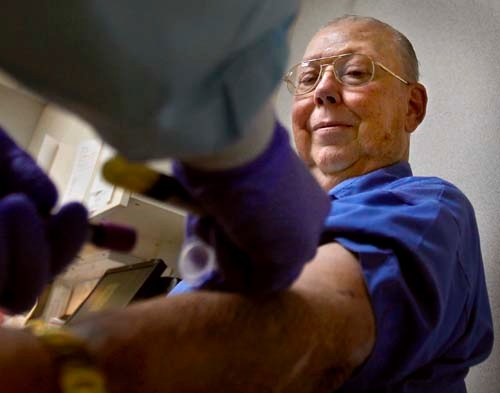Event seeks to raise awareness for prostate cancer
Morphine couldn't blot out the pain. He screamed so loudly he thought he could be heard in Los Angeles and clenched his teeth deep into his gums to try to stop screaming.
"My teeth are only now beginning not to hurt and that was two weeks ago," John Quinn said as he leaned back in a chair in his Summerlin home and talked about dealing with cancer of the prostate, a small walnut-size gland that makes up part of a man's reproductive system.
With an oxygen tube in his nose, the 63-year-old movie and TV producer labored to breathe as he recalled how the prostate cancer he had been battling for years seemed to shift into another gear to eat away more furiously at his bones.
"The pain felt like somebody was driving nails into my legs," he said.
The end seemed so near in late August that he was placed in a hospice. Then a strange thing happened as Quinn lay there waiting to die. For reasons he still can't explain, he started to feel energy creep back into his system. Maybe the effects of a blood transfusion kicked in. Or just maybe a new prostate drug called Zytiga, which he started days before, had begun to work.
A few days after entering the hospice he felt well enough to go home.
"I've always felt if I hung in there long enough, they'd find something that's going to work," he said. "I don't know if this is the drug, but maybe it'll give me some time until another one comes along."
Only because he said he still feels "kind of weak" will Quinn miss Saturday's inaugural "This One's for the Boys!" event, a two-mile walk at UNLV's Track & Field Stadium. September is Prostate Cancer Awareness Month, and the event is designed to raise funds for those with cancer and emphasize the need for screenings and more research.
Organizers hope the walk becomes as big as the Susan G. Komen Race for the Cure, which is held each May in Las Vegas and other cities.
It is the kind of social and educational gathering, Quinn said, that is necessary to help persuade the public to support a cure for prostate cancer, a disease that kills one man in the United States every 15.6 minutes, in the same way it supports finding a cure for breast cancer.
"The way it is now is not only not fair but crazy," he said. "Men deserve the same attention as women when it comes to research for cancer."
Many prostate cancer survivors -- including Marine veteran Chester Toso of Las Vegas -- point to the fact that the National Cancer Institute dedicated more than $630 million to breast cancer research last year, more than double the amount allotted for prostate cancer research.
Yet both diseases hit their victims in similar fashion. One in seven women will develop breast cancer in her lifetime while one in six men will develop prostate cancer. The National Cancer Institute estimates that 240,890 men will be hit for the first time by prostate cancer this year -- 10,000 more than those stricken initially with breast cancer. And the government estimates breast cancer will kill more than 39,000 women this year, with 33,000 men dying of prostate cancer.
"I just think research funds must be given out fairly," said the 74-year-old Toso, who was at a Comprehensive Cancer Centers of Nevada treatment center recently for testing before receiving a new drug for his late-stage prostate cancer.
Tony Crispino, head of the Las Vegas chapter of the UsTOO Prostate Cancer Support Group, went to Washington, D.C., earlier this week to lobby Congress to allocate more research funding for prostate cancer.
"We have two very similar disease problems, but we have nowhere near the support of the government or the private sector that the girls have," he said. "This is a very serious lesson for the guys. ... Women got people involved.
"We don't need to slow the commitment to breast cancer, or any cancer, but we do need to raise the bar for prostate cancer research."
Two respected cancer physician-researchers, Dr. Oscar Goodman Jr. of the Nevada Cancer Institute and Dr. Nicholas Vogelzang, of Comprehensive Cancer Centers of Nevada, agreed that women and their supporters have been more aggressive at getting their message out.
"They've been much better at lobbying for research funds," Goodman said.
In the '80s, when a big push was on for research money, Vogelzang said breast cancer surgeons "were more politically adept" than urologists.
Prostate cancer survivors haven't been particularly good at pleading their own case, Crispino admitted. Many are too embarrass ed to talk about a disease that takes a significant toll on male potency. Treatments leave the majority of men unable to have intercourse, according to studies.
"There's no doubt that the reason men have a hard time talking about the disease is because of what it does to them," Quinn said. "I'm just glad we're starting to talk about it publicly. I think women had to go through a time of embarrassment before they talked about breast cancer with so much ease. But I'm not sure it'll ever be easy for a man to say he can't get it up any longer."
There is an indication that it's becoming easier for men to talk about prostate cancer. Former National Football League stars fanned out across the nation this month to help with an educational campaign urging men to get screened.
Both Vogelzang and Goodman said much of their discussions about treatment with patients involves whether the man will be able to have intercourse later. There are times, both doctors said, that men feel so strongly about their sexuality that they refuse treatment and die soon afterward.
"It's sad," Goodman said.
The five-year survival rate for prostate cancer if it remains localized is almost 100 percent. Surgery and radiation are very successful if the disease, which is generally slow-growing, is caught early. If the cancer spreads, however, the survival rate at five years falls to 31 percent.
Like most men with prostate cancer, Quinn was diagnosed through a routine PSA test, which measures the amount of prostate specific antigen in the blood. It came back high.
He wishes now he hadn't tried a holistic approach to treatment when first diagnosed and opted for surgery and radiation instead.
Today, his hair is whiter than chalk, but not much whiter than his face, which carries a kind of porcelain sheen that doctors call "the Casper the Ghost syndrome" -- a depigmentation of skin brought on by XL184, an experimental drug showing effectiveness in treating tumors that have spread to the bone.
If the money is there, Quinn has no doubt that researchers will find a cure for prostate cancer. He wondered if he saw what it would be like in a recent dream.
"I was lying there, and I saw all these little electrical things inside my body killing cancer cells. Legs, arms, everywhere. My body felt great as the dream went on. "
Contact reporter Paul Harasim at pharasim@review journal.com or 702-387-2908.
PROSTATE CANCER EVENT
What: "This One's for the Boys!" 2-Mile Walk
When: 8:30 a.m. Saturday
Where: UNLV Track & Field Stadium (Swenson & Harmon)
Register: Online at 21stCenturyCare.org for $25 or at the event for $30.
Sponsors: UsTOO Prostate Cancer Support Group & 21st Century C.A.R.E. Foundation


















